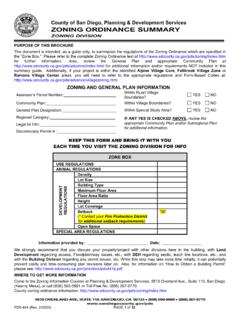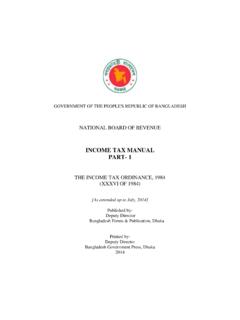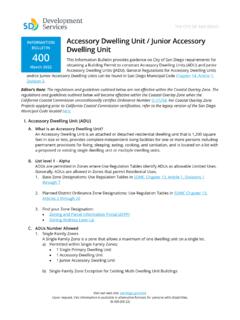Transcription of Houston, Texas Noise Ordinance
1 1 houston , TexasNoise OrdinanceSec. following words, terms, and phrases, when used in this chapter, shall have the meaningsascribed to them in this section, unless the context of their usage clearly indicates anothermeaning:Daytime hoursshall mean the hours from 7:00 on one dayand 10:00 the same (A)shall mean the intensity of a sound expressed in mean any occurrence or set of circumstances involving actual or imminentphysical trauma or property damage or loss that demands immediate workshall mean any work performed for the purpose of (i) preventing or alleviatingthe physical trauma or property damage threatened or caused by an emergency, (ii) restoringproperty to a safe condition following a fire, accident, or natural disaster, (iii) protecting personsor property from exposure to danger, or (iv) restoring public hoursshall mean the hours between 10:01 on one day and 6:59 thefollowing propertyshall mean any realproperty that is not included in the definition ofresidential property as defined in this section.
2 Without limitation, the term includes propertiesthat have been developed other than as residential properties, properties that are undeveloped,and properties that are devoted to public purposes, such as public streets and lineshall mean, with respect to single occupancy properties, the line along the groundsurface and its vertical extension that separates the real property owned, leased,or occupied byone person from that owned, leased, or occupied by another person. With respect to sharedoccupancy properties the term shall mean the imaginary line that represents the legal limits ofoccupancy of any person who owns, leases, or otherwiseoccupies an apartment, condominium,hotel or motel room, office, or any other type of occupancy from that of other propertyshall mean any real property developed and used for human habitation thatcontains living facilities, including provisions for sleeping, eating, cooking, and sanitation,unless such premises are actually occupied and used primarily for purposes other than nuisanceshall mean any sound that either exceeds the maximum permitted sound levelsspecified in section 30-6 of this Code, or for purposes of sections 30-3, 30-4, and 30-5 of thisCode, otherwise unreasonably disturbs, injures, or endangers the comfort, repose, health, peace,or safety of others.
3 (Ord. No. 01-945, 2, 10-17-01)Sec. prohibitions.(a)It shall be unlawful for any person to make, continue, or cause to be made or continued anyloud, unnecessary, or unusualnoisethat annoys, disturbs, injures, or endangers the comfort,repose, health, peace, or safety of others. In determining whether anoiseis loud, unnecessary, orunusual, the following factors shall be considered: time of day; proximity to residentialstructures; whether thenoiseis recurrent, intermittent, or constant; the volume and intensity;whether thenoisehas been enhanced in volume or range by any type of electronic or mechanicalmeans; and whether thenoiseis subject to being controlled without unreasonable effort orexpense to the creator (b)It shall be unlawful for any person to make, assist in making, permit, continue, cause to bemade or continued, or permit the continuance of any sound that either exceeds the maximumpermitted soundlevels specified in section 30-6 of this Code or, for purposes of sections 30-3,30-4, and 30-5 of this Code, otherwise unreasonably disturbs, injures, or endangers the comfort,repose, health, peace, or safety of others.
4 (c)The acts enumerated in the following sections of this chapter, among others, are declared tobe loud, disturbing, and unnecessarynoisesin violation of this chapter, but such enumerationshall not be deemed to be exclusive.(Ord. No. 01-945, 2, 10-17-01)Sec. vehicles use of any motor vehicle so out of repair, so loaded, or so noisy that it creates any loud andunreasonable grating, grinding, rattling, or any other loud and unreasonable sound is herebyprohibited and declared to be unlawful.(Ord. No. 01-945, 2, 10-17-01)Sec. sound.(a)It shall be unlawful for any person to make, assist in making, permit, continue, cause to bemade or continued, or permit the continuance of any sound using any sound amplifier that is partof or connected to any speaker system, radio, stereo receiver,compact disc player, cassette tapeplayer, microphone, or any other sound source, when operated: (i) in such a manner as to disturbthe peace, quiet, and comfort of the neighboring inhabitants, or (ii) at any time with loudervolume than is necessary for convenient hearing for persons who are in the vehicle or within theproperty or premises in which such sound amplifier is operated and who are voluntary listenersthereto.
5 The operation of any such sound amplifier in such a manner as to be plainly audible at adistance of 50 feet from a vehicle shall be presumed to be violative of this section. The operationof any such sound amplifier in such a manner that bass sounds are plainly audible at a distance of50 feet from the property line of a property or premises in which the amplification is locatedshall be presumed to be violative of this section.(b)It is an affirmative defense to prosecution under this section that the sound source is a motorvehicle and that (i) the motor vehicle is a mobile sound stageor studio that is being used on astationary basis at a location not situated upon any street for the purpose of providing sound,during daytime hours, for an event or function and (ii) the use is in compliance with all otherprovisions of this chapter, including but not limited to section 30-8 of this Code, if applicable.(Ord. No. 01-945, 2, 10-17-01)Sec.
6 Animals and keeping of any animal or bird that causes or makes frequent or long and continued soundthat unreasonably disturbs, injures, or endangers the comfort, repose, health, peace, or safety ofordinary, reasonable persons of normal sensibilities and ordinary tastes, habits, and modes ofliving who reside in the vicinity thereof is herebyprohibited and declared to be unlawful as asound nuisance in violation of this chapter, regardless of whether the sound so created by saidanimal or bird is within the permissible levels specified in section 30-6 of this Code.(Ord. No. 01-945, 2, 10-17-01)3 Sec. permissible sound levels.(a)In addition to the violations established by the preceding sections of this chapter, no personshall conduct, permit, or allow any activity or sound source to produce a sound discernible at anylocation beyond the property lines of the property on which the sound is being generated thatwhen measured as provided in section 30-7 of this Code exceeds the applicable dB(A) levellisted below forthe property on which the sound is received:(1)Residential dB(A) during daytime dB(A) during nighttime hours.
7 (2)Nonresidential property:68 dB(A) at all sound that exceeds the dB(A) levels set forth in this section under the conditions andmeasurement criteria set forth in this chapter is a violation of this chapter. Evidence that anactivity or sound source produces a sound that exceeds the dB(A) levels specified in this sectionshall be prima facie evidence of asound nuisance that unreasonably disturbs, injures, orendangers the comfort, repose, health, peace, or safety of others in violation of this chapter.(b)Regardless of the measurable dB(A) level established above and measured as provided insection 30-7,below, the generator of any sound of such a nature as to cause persons occupyingor using any property other than the property upon which the sound is being generated to beaware of sympathetic vibrations or resonance caused by the sound shall also be prima facieevidence of a sound that unreasonably disturbs, injures, or endangers the comfort, repose, health,peace, or safety of others in violation of this chapter.
8 (Ord. No. 01-945, 2, 10-17-01)Sec. ofsound portions of this chapter prohibit sound over a certain decibel limit, measurement shallbe made with a Type 1 or Type 2 calibrated sound level meter utilizing the A-weighting scaleand the slow meter response as specified by the American National Standards Institute ( ). Measurements recorded shall be taken so as to provide a proper representationof the sound being measured. The microphone of the meter shall be positioned so as not to createany unnatural enhancement or diminution of the measured sound. A windscreen for themicrophone shall be used. Measurements of sound generated shall be taken from the propertyline of the nonresidential property or residential property where the sound is received to thesource of the sound.(Ord. No. 01-945, 2, 10-17-01)Sec. required for use of outdoor sound amplification equipment.(a)No person shall use or cause to be used any loudspeaker, loudspeaker system, soundamplifier, or any other machine or device that produces, reproduces, or amplifies sound outsideof buildings or other enclosed structures in a manner that exceeds the levelsspecified in section30-6, when measured from the property where the sound is being received, without firstobtaining a permit to do so.
9 The permit shall be granted only for the amplification of music orhuman speech, or both. The permit:(1)May be obtained by making application to the director of the city department sodesignated by the mayor.(2)Requires payment of a $ fee for the administrative costs of issuing the permit ora sworn statement of inability to pay the (3)Is valid for one 14hour period between the hours of 8:00 and 10:00 (4)Shall not be issued to the same or any other person for the same location more thantwice during any 30 day period. In the case of a sound truck, location shall relate to thearea traversed bythe truck in one day.(5)Shall not authorize, allow, or otherwise permit the production, reproduction, oramplification of sound that exceeds 75 dB(A) when measured from the property line ofthe nearest receiving property.(b)The permit application required to be filed pursuant to this section shall contain the followinginformation:(1)The date of the application and the date and hours for which the permit is requested.
10 (2)The name and address of the applicant.(3)The name and address of the personwho will have charge of the sound amplifyingequipment.(4)The purpose for which the sound equipment will be used.(5)The address and a description of the location where the sound equipment will be used.(6)A description of the type of sound amplifyingequipment to be used.(Ord. No. 01-945, 2, 10-17-01; Ord. No. 2010-1016, 2, 12-15-2010)Sec. following defenses shall apply to any offense established in this chapter:(a)The emission of any sound was for the purpose of alerting persons to the existence of anemergency, danger, or attempted crime.(b)The sound was produced by an authorized emergency vehicle.(c)The sound was produced by emergency work.(d)The sound was generated:(1)At a lawfully scheduled stadium event;(2)By a parade and spectators and participants on the parade route during a lawfulparade;(3)By spectators and participants at lawfully scheduled amphitheater event;(4)By patrons and participants using cannons and gunfire during historical battle re-enactments for which a pyrotechnic permit was obtained and the explosives wereinspected by the fire marshal;(5)By a pyrotechnic display that was inspected and approved by the fire marshal; or(6)By spectators and participants of any outdoor event, fun run, race, festival, fiesta, orconcert that was sponsored or cosponsored by the city and in full compliance with apermit issued by the city.

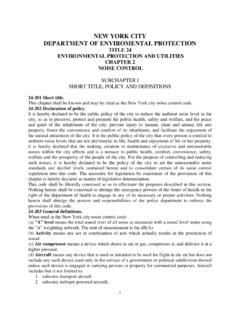


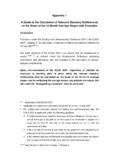
![Ministerial Ordinance [GQP]](/cache/preview/3/3/6/6/8/e/5/4/thumb-33668e54a54dfd1081c8f0412615f824.jpg)
